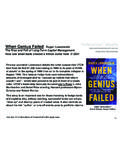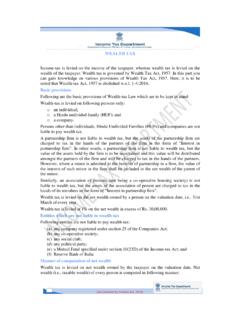Transcription of Young Adults’ Version Instructor guide
1 Young Adults VersionInstructor guide 2003, 2013 Wells Fargo Bank, All rights reserved. Member FDIC. ECG-714394 Version ON BANKING Instructor guide Young ADULTS Version 2003, 2013 Wells Fargo Bank, All rights reserved. Member FDIC i of iiiWelcome to Wells Fargo s Hands on Banking program!This fun, interactive, and engaging financial education program is designed for both self-paced, individual learning and classroom use. These Instructor Guides are designed to help you share this valuable program with groups of any these guides, you ll find everything you need to lead participants through real-life scenarios, group discussions, and activities that will encourage them to apply these lessons to their daily sharing the Hands on Banking program with others, you ll help them to take control of their finances and build a brighter financial Hands on Banking program covers all the basics of smart money management.
2 The curriculum is designed for four age groups: Adults, Young Adults (ages 15 21) Teens (grades 6 8) and Kids (grades 4 and 5).The Hands on Banking program is an easy and enjoyable way to teach and learn the essentials of financial education: the basics of bank services, the importance of saving, smart money management, using credit responsibly, invest-ing, wealth building, and more. Whether it s opening a checking account, avoiding identity theft, paying for college, applying for a credit card, or starting a small business, the Hands on Banking program provides real-world skills and knowledge everyone can s easy to integrate the Hands on Banking program into the classroom.
3 The lessons for school-aged students are aligned with national and state educational standards for economics, financial literacy, mathematics, and English language segments in this program adhere to the following economics, financial literacy, mathematics, and English lan-guage arts standards: National Council of Economic Education, the National Association of Economics Educators, and the Foundation for Teaching Economics, Voluntary National Content Standards in Economics (1997). For details, see JumpStart Coalition for Personal Financial Literacy, National Standards in K-12 Personal Finance Education (2007).
4 For details, see National Council of Teachers of Mathematics, Principles and Standards for School Mathematics (2000), Grades 9-12. For details, see The National Council of Teachers of English (NCTE) and International Reading Association (IRA), Standards for the English Language Arts (1996); Grades K-12. For details, see HANDS ON BANKING Instructor guide Young ADULTS Version 2003, 2013 Wells Fargo Bank, All rights reserved. Member FDIC ii of iiiUsing the Instructor Instructor Guides can be used alone or as an adjunct to the online/CD-ROM program; however, we strongly encourage you to review the program online or request a free CD-ROM.
5 Even if participants will not experience the program online, gaining familiarity with the online program will help you present it more effectively. The online pro-gram includes simulations, calculators and an extensive resource library to help supplement these guides please take advantage of all these great resources. Each topic in the Hands on Banking program has its own Instructor guide which follows the organization of the online program and includes much of the same content. The Young Adults Version of the Hands on Banking program includes six topics:1.
6 Getting Earning $.3. Spending Save, Invest & Build All About School & $.Each Instructor guide includes: A glossary of all the relevant terms introduced in the topic. A lesson introduction which includes: An overview. Learning objectives. Sample discussion questions to start the lesson. The Basics a list of bullet points outlining the key concepts of the lesson. A lesson summary of all the key concepts of the lesson. Activities, quizzes, discussion questions, handouts and important tips for key concepts. A topic summary that lists all the major concepts of the topic.
7 Additional activities designed to extend the concepts presented in the topic to the real world. A Library Resource section that includes additional reference materials and instructions for organizing your group for activities are recommendations only. You know what will work best when it comes to teaching and engaging your group. HANDS ON BANKING Instructor guide Young ADULTS Version 2003, 2013 Wells Fargo Bank, All rights reserved. Member FDIC iii of iiiLesson Concepts and lesson of a topic will present several key concepts.
8 These concepts are introduced to your participants in a variety of ways which are represented in the guides by these activity usually involves some sort of class participation, whether it is a matching game, a fill in the blank exercise, or worksheet completion. Typically after an activity you will have the opportunity to lead a allow you to introduce key concepts while involving your participants in the conversa-tion and making the information relevant to them. In some places, sample discussion questions are included to help you guide the discussion.
9 All the topics, there are short quizzes designed to start discussions or quickly test partici-pants knowledge of certain concepts. of the Instructor Guides include handouts that are designed as a resource for your participants to use outside the classroom in their daily lives. For example, one handout includes a list of web links for participants to use as they start, grow and manage their small business. Activity and Discussion during a lesson, an activity or discussion will also use a handout to teach key concepts. In these cases the Handout icon is placed below the Activity or Discussion icon.
10 Transition icon will let you know when the next concept is related to or follows up on the con-cept you re presently discussing or covering with your participants. Library online/CD-ROM Version of the Hands on Banking program includes a vast library with relevant articles, checklists, and worksheets for each topic and lesson. Relevant library articles are recommended at the end of each lesson. These articles provide additional information to use in teaching key concepts (look for the library icon as seen above). We encourage you to review the full library selection online or on the CD-ROM.







